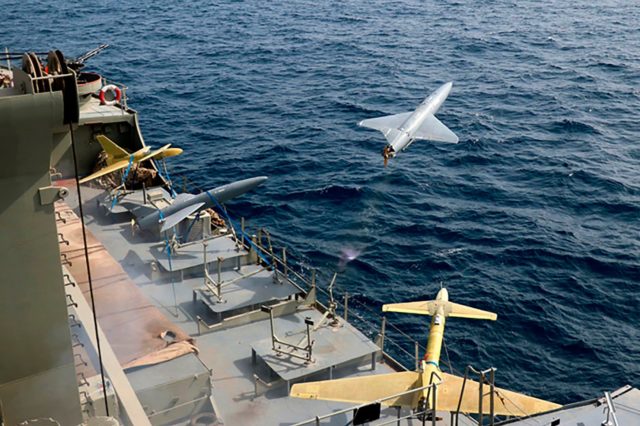Iran is selling drones they are not supposed to have to Russia, and Russia is using Iranian drones to attack Ukrainian civilians—a combination of UN sanction-busting and war crimes that cannot go unpunished. But what form of punishment remains in the Western playbook?
President Joe Biden’s press secretary was specific in her recent denunciation of the Russian drone attack on an apartment building in Kyiv that killed at least four Ukrainian civilians: “We will continue to impose costs on Russia [and] hold them accountable for its war crimes.” The State Department says it will crack down further on Iran. The U.S., France, and Britain also agree that Iran supplying drones to Russia violates the UN Security Council resolution that endorsed the 2015 Iranian nuclear deal.
And, so?
Western sanctions have targeted Russia’s financial and energy sectors, dual-use goods, gold, airline flights, and more than 1,000 individuals and their assets. There has been no appreciable softening of Russia’s attitude toward the West, toward Ukraine, and toward the war. But in a significant breach of Western solidarity, the Dutch government has issued 91 waivers to exempt Dutch companies from sanctions against Russia.
The UN, EU, and U.S. have all sanctioned Iran at some point since 1980. Iran had been under a UN Security Council conventional arms embargo—exports as well as imports. Additional sanctions imposed by the Trump administration had thoroughly drained Iran’s foreign currency reserves and created negative economic growth in 2018-19. But one set of UN restrictions came off in 2020—over the objection of the outgoing Trump administration—and the Biden administration eased U.S. sanctions beginning in early 2021.
Western diplomats point out that UN restrictions on missiles and related technologies were slated to remain until October 2023. Drones were included in the list of restricted technologies.
But Iran treats all the embargoes and sanctions the same way: It cheats. Iran had been importing parts and building drones all along, and sold them when it had the right buyer. In this case, the buyer is Russia, which is finding it more difficult to produce weapons and is turning to imports from its partners, including Iran and North Korea.
So, while the embargo remains, the drones are now there.
And we knew it. Months ago, Iran’s ground forces commander said, “Currently, we are ready to export military equipment and weapons,” acknowledging the U.S. accusation that Iran was preparing to send “several hundred drones” to Russia. In September, well before the drone attack on Kyiv, the U.S. sanctioned four Iranian firms for drone production and for their military transport to Russia. After denying the sale for a time and skipping over the UN embargo, Iran agreed that the transfer took place, but insisted that it had no responsibility for subsequent Russian actions. “Where they are being used is not the seller’s issue,” one Iranian diplomat said.
These are not model airplane drones. According to a report in Asia Times, Russia has acquired the Iranian “Shahed-129 (a Predator drone knock-off), the Mohajer-6 (built especially for Iran’s Islamic Revolutionary Guard Corps and carrying two missiles), and loitering munition drones Arash-2 (allegedly designed to hit Tel Aviv and Haifa), Shahed-136 and Shahed-131.”
It was the Shahed-136, according to The New York Times, that struck Kyiv. A U.K. Ministry of Defense intelligence update notes that particular drone has been used by Russia since at least August. Ukrainian sources report that along with the civilian casualties, the drones have damaged or destroyed at least 40% of Ukraine’s energy infrastructure, leaving parts of Kyiv without power and water.
This raises serious—and related—issues. What is the penalty to Iran for building and exporting weapons banned by the UN? And what is the penalty to Russia for using those weapons? And what is the penalty for the destruction of civilian infrastructure and the killing of civilians in the process? From February 24 to October 31, 2022, the UN High Commission for Human Rights recorded 16,295 civilian casualties in Ukraine: 6,430 killed and 9,865 injured.
Russia’s foreign currency reserves have been increased by the energy sanctions as the embargo proved to be partial, and the rising prices allowed Russia to make more money selling fewer goods. Europe and the U.S. have been more inconvenienced than Vladimir Putin. Iran is in the midst of a brutal crackdown on its unhappy populace, killing more than 200 people according to an Iranian human rights watchdog and prompting Vice President Kamala Harris to threaten the removal of Iran from the UN Commission on the Status of Women.
So, more sanctions?
It is worth remembering that the Trump administration took direct action against Syria after the Bashar al-Assad regime deployed chemical weapons against its own people. And Israeli intelligence has determined that Iran will not have missile or drone factories in Syria.
Whatever choices the West—and the United States, as the putative leader of the West—makes, more sanctions are not the answer.






